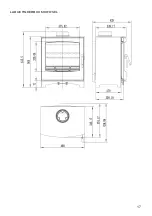
9
stoking should burn down to embers before new
logs are added.
To obtain the best possible combustion, you
should regulate the effect/heat output with the
fuel and Air. Burning small logs provides more
powerful combustion than burning large logs
as the surface area is greater and more gas is
released.
The amount of wood in the combustion chamber
is another factor that affects combustion. The
optimum combustion is achieved by placing two
logs in the stove. If you want an enhanced effect,
you can add more logs.
The ideal heat output is reached by burning
approx. 1,5 kg per hour.
3.5 LIGHTING A FIRE WHEN USING WOOD
The fire lighting method is very important for
starting combustion quickly and efficiently.
1. Open all the Air control fully.
2. Place a small log of wood crosswise in the
combustion chamber and put 2 firelighters
close to the log. Put a new small log close to the
firelighters and place several sticks of kindling
at an angle above it in a cross hatch shape. Air
must be able to reach the firelighters, but the
logs should be touching to “warm” each other.
Light the firelighters with a match.
3. Keep the door approx. 1 cm ajar, until the glass
is too hot to touch. Then close the door. When
there are distinct, visible flames and the fire has
taken hold.
Warning:
The control and handles will get warm
when the wood burning stove is in use. Please
use the glove provided when you operate the
wood burning stove.
4. Once the first charge of wood has burnt away
leaving a glowing bed of embers you should
be able to shut of the primary air controls.
Slowly open the stove door using the glove
provided and re-stoke the fire with the desired
amount of wood. Close the door and open the
secondary air control to maximum for a few
minutes to allow the new wood to catch fire
then slowly push the air control back into the
stove until the desired effect is reached.
In order to avoid the quenching of the stove
fire by use of oversized logs we recommend a
maximum wood fuel size of 4” (10cm) diameter
by 10” (25cm) length split seasoned logs, with a
maximum moisture content of 20%.
This appliance is designed to operate with the
door closed, except for lighting and reloading,
failure to close the door during operation can
result in fume spillage.
Warning:
Properly installed, operated and
maintained this appliance will not emit fumes
into the dwelling.
Occasional fumes from re-fuelling may occur.
However, persistent fume emission is potentially
dangerous and must not be tolerated. If fume
emission does persist, the following immediate
actions should be taken:
Open doors and windows to ventilate room then
leave the premises. Let the fire go out or eject and
safely dispose of fuel from the appliance.
Check for flue or chimney blockage, and clean
if required. Do not attempt to relight the fire
until the cause of the fume emission has been
identified and corrected. If necessary seek expert
advice
3.6 IMPORTANT INFORMATION FOR
WOOD BURNING
With a full load of wood and burning near
nominal output the stove will need to be refuelled
approximately every 1-1.5 hours. One or two large
logs will burn longer than a number of smaller
ones.
Care must be taken that logs do not touch the
baffle or the glass panel. Do not stack logs above
the level of the tertiary air inlet profiling in the rear
vermiculite firebox liners at the back of the stove.
Always make sure that flames are visible above
the wood after re-fuelling for cleanest burning.
Burning without flames above the fuel will create
unnecessary smoke. After re-fuelling open the
primary air control fully for 3 minutes or until the
logs are fully blackened to achieve full flames
above the fuel.
Wood burns best on a bed of ash and it is
therefore only necessary to remove surplus ash
from the stove occasionally. Burn only dry, well-
seasoned wood, which should have been cut, split
and stacked - under cover from rain - for at least
12-24 months with free air movement around the
sides of the stack to enable it to dry out.
Burning wet or unseasoned wood will create tar
deposits in the stove and chimney and will not
produce a satisfactory heat output. Wood that
is not properly dry (‘dry’ is considered to be less
than 20% internal moisture content) uses up
energy from the burn process to evaporate the




































